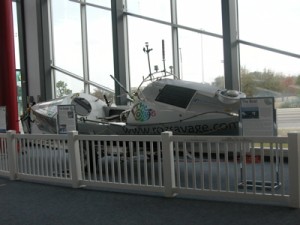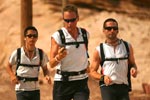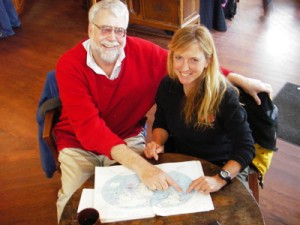
I've just received this photo of Sedna in her new temporary home at the Museum of Science and Industry in Tampa.
As far as I can tell from this and some other pictures, she doesn't seem to have suffered too much damage in transit, despite an ill-fitting trailer. I will need to get a replacement trailer before I set out on 1st April to drive her 3000 miles from Florida to San Francisco.
Chances are that she will need an entirely new electrical system, but this will give me a good excuse to implement some exciting new technology. There is lots of activity going on at the moment around 'Project WatchKeeper' - by which I hope to send back a wealth of data to my website while I am out on the Pacific, covering weather, navigation, and environmental parameters, as well as information about how I'm coping physically and psychologically. If it all works out, it will be really coooolllll!
|
|

After major logistical and legal nightmares - largely revolving around trying to get a boat trailer bought in Antigua street-legalised in the US - my boat Sedna has at long last arrived at the Museum of Science and Industry in Tampa, Florida. I still haven't seen her, as I'm 3500 miles away on the West Coast. The report on her condition from MOSI is as follows:
"The interior of the cockpit was covered in tree debris and water. We have vacuumed all the water out and are working at cleaning the tree 'crud' from the fiberglass surfaces. It may have stained the surfaces a little.
As you may know, the boat does not sit well on this trailer and it actually has rotated a little and is not sitting 'flat'. I don't know what stresses that is putting on the hull..."
Interesting...
I'm still finalising my schedule for the next few months, but chances are that the first time I'll see Sedna will be at the end of March. Given that there have been no reports of major structural damage, I'm optimistic that we can have her shipshape in plenty of time for my July launch date.
So I'm not panicking yet. I was already expecting her to be rusty, mouldy, and to need an entirely new electrical system. I'm hoping that the rest of her problems are nothing that a good clean-up and a lick of paint won't solve.
In the meantime, I would like to hereby give thanks where thanks are due. I am forever indebted for the huge and generous contribution of time and effort by Scott Stemm, the brother of a friend of a friend, whom I've never even met. It is due to the kindness of strangers such as Scott that crazy expeditions like mine are made possible. If you ever feel jaded about human nature, I would highly recommend embarking on an ambitious adventure - it absolutely brings out the best in your fellow man (and woman). I am constantly amazed at the generosity and altruism of people who have nothing to gain other than the possibility of profuse thanks and a bit of reflected glory - and of course, a mention on my website. Thanks, Scott - and to Greg his brother, and also to Josh and Daniel Sampiero who retrieved Sedna from hock in the port of Miami. I look forward to meeting these two pairs of brothers when I make it over to Florida, and saying thank you face-to-face.
|
|

Wow. If I was ever under any illusions that rowing an ocean was hardcore, check out what these guys have just accomplished... running 4000 miles across the Sahara Desert, running up to 50 miles a day. Phew.
|
|

In Seattle on Monday I had a meeting with Bob Pavia from the National Oceanic and Atmospheric Administration - also known as NOAA. (Someone did comment, when they heard I was going to be meeting Noah, 'I didn't know he was still around.')
Spurning Seattle-based Starbucks, We met somewhere much better - Zoka's Coffee Shop - to discuss my environmental message for the Pacific row: the huge problem of marine plastic pollution.
'While you're here,' Bob said, 'You should try and meet Curtis Ebbesmeyer, the guy who tracked the Nike trainers when they went overboard from a container ship. He lives just a few blocks away.' A quick Google or two turned up a phone number, and Curtis came to meet me in Zoka's.
The photo shows us poring over a map of the world, on which Curtis has marked the huge 'Garbage Patches' - the areas in the centre of ocean gyres where rubbish accumulates. My route from San Francisco to Hawaii will take me past the Great Northern Garbage Patch - an area roughly four times the size of Texas. Curtis estimates that the patch holds around 200 shipping containers and 50 deserted yachts as well as discarded refrigerators and TV's.
During my row I will be logging any sightings of debris, including a GPS position. I will need to see this with my own eyes. It sounds awful almost beyond belief.
|
|